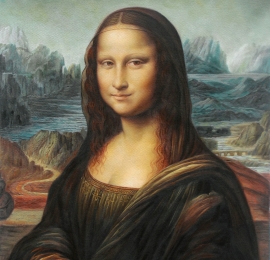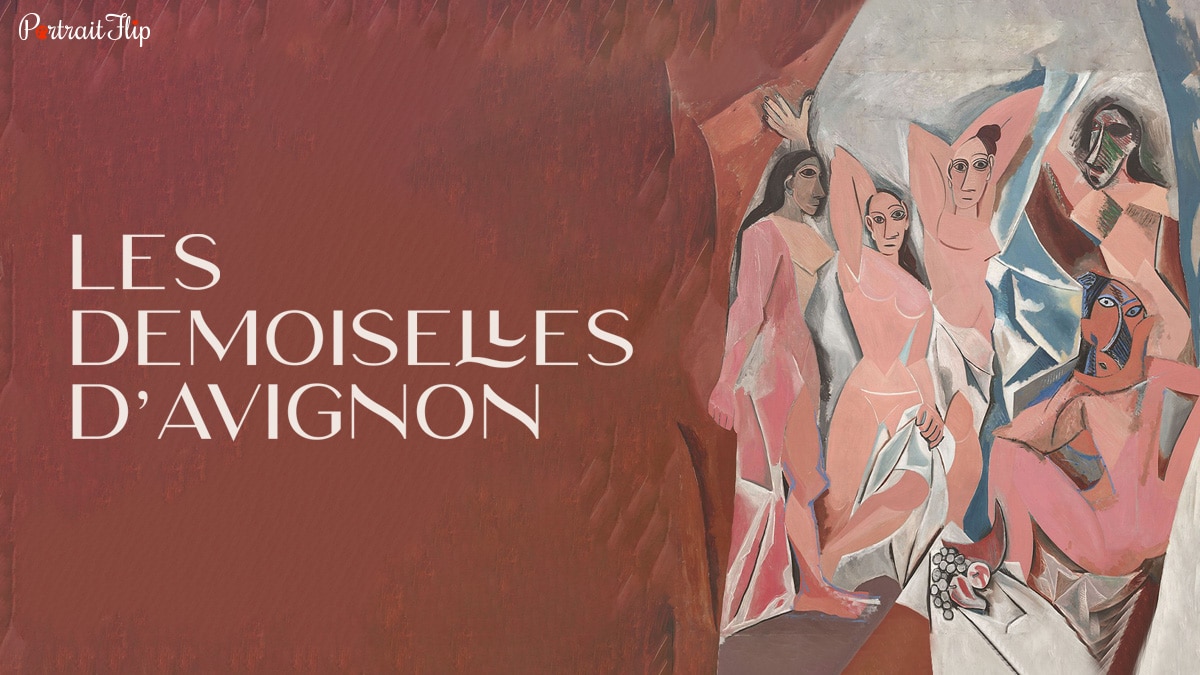Art is the most proficient form of expression. It has the audacity to provoke, ignite, and sometimes even elevate emotions.
There are many paintings that are based on provocative themes. Some of them are deliberate; the rest are just differences of interpretation.
One such ambiguous painting was Les Demoiselles d’Avignon, created by a famous Spanish artist, Pablo Picasso, in 1907.
It gained huge popularity for different reasons! Don’t worry; we’ll explore them in this blog.
The title of this painting is in French, and “demoiselles d’avignon” translates to “The women of Avignon” in English.
It portrays a very peculiar theme altogether, which is very different from what the title suggests.
By presenting an unconventional theme, it spawned a new benchmark for Picasso’s paintings.
You wish to explore this accolade. Don’t you?
Let’s get acquainted with Les Demoiselles d’Avignon and the inspirations behind it..
Table of contents
The History behind Les Demoiselles d’Avignon
Pablo Picasso was a true artist. His paintings were visual representations of his emotional timeline.
Some of his artworks, like Guernica depict the sorrow he went through during the Spanish Civil War. This fact also justifies the ardent side of the artist.
Those who know a bit about Picasso might also have an idea about his Blue Period. Surprisingly, Pablo Picasso’s Les Demoiselles d’Avignon marked the end of his Blue Period.
This antique artwork began the era of cubism. It’s believed to be the maiden artwork of Cubism by Picasso. After which, he left a trail of amazing Cubist paintings.
Picasso created this masterpiece by drawing inspiration from two historical notions. Iberian Sculptures and African figurative art
They emerge as major highlights of this painting as they have a significant historical context to unfold.
Significance
It is evident that paintings with a massive following turn out to be significant for multiple reasons.
For instance, paintings by Kandinsky not only elevated the standards of Russian art but also gave a new meaning to abstract art.
Similarly, Les Demoiselles d’Avignon contributed to the cultural shift for artists during the early 20th century.
It acted as an element of equilibrium between figurative painting and abstract art!
Considering the timeline of Modern Art, the nature of artists and their artworks started becoming a bit contradictory in the early 20th century.
Many famous paintings produced during this time depicted a sense of self-contradiction after analysis.
However, Les Demoiselles d’Avignon justified the message it wanted to convey with clarity.
With adequate involvement of flat planes and edges, Les Demoiselles d’Avignon showcased elements of cubism embedded as well.
Also Read: About Salvator Mundi
Théories & Speculation around Les Demoiselles d’Avignon
Popular artworks often end up in clutches of controversy. Sometimes, even if the reason is not specified, the artwork tends to suffer the backlash anyway.
Similarly, Picasso’s Le Demoiselles d’Avignon also went through a tornado of rumors when it came out in 1907.
The Cézanne Angle
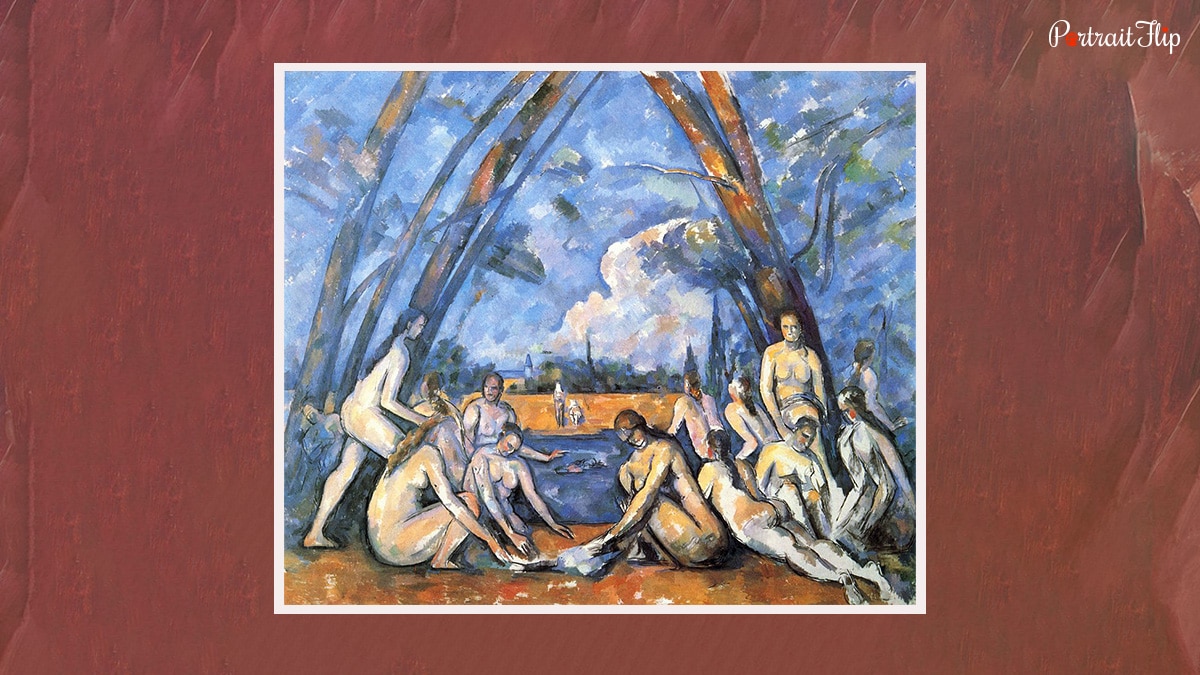
Famous French painter Paul Cézanne produced an immaculate masterpiece, “The Large Bathers,” in 1898.
It revolved around the central theme of depicting naked women with a natural essence while bathing.
Now, after nine years, Pablo Picasso has released his artwork showing “The Young Ladies of Avignon”.
This fact gave birth to the theory of replication between The Large Bathers and Les Demoiselles d’Avignon.
Many art critics accused Picasso of copying Cezzane’s theme and spoiling his artwork’s originality.
However, Picasso was influenced by Cezzane’s paintings. Hence, he derived inspiration from the former’s paintings.
Racial Remark
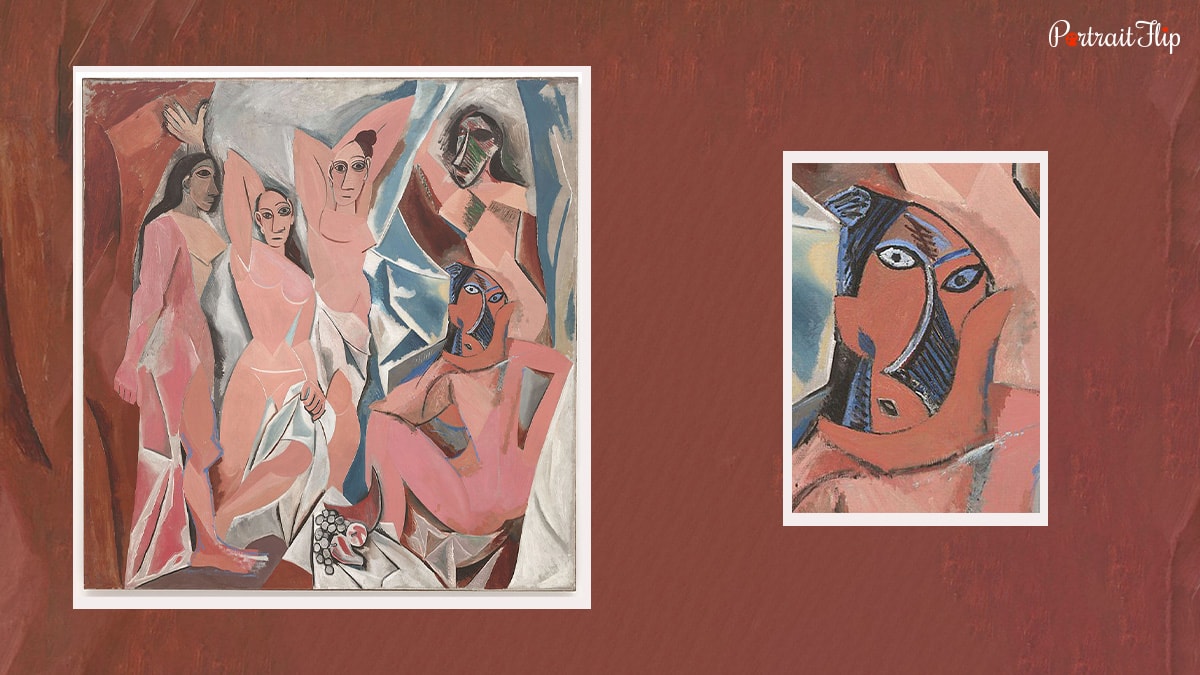
The figurative scheme of this painting revolves around the depiction of women on the streets of Avignon. Ladies who are depicted as prostitutes, seem to belong to a particular ethnic group.
This fact is evident after looking at the color scheme of the painting. The use of dark brown suggests their ethnic background at a glance.
This fact threw Picasso into a pit of allegations. Even many people reacted to Demoiselles d’avignon by Picasso in a hostile manner.
They expressed their anger towards Picasso’s idea of punching down on women of a particular race and showing them in a bad light.
However, It was later found that the composition of human subjects in”Les Demoiselles d’Avignon” by Pablo Picasso is inspired by the Iberian sculptures that he was researching.
Themes and Symbols
Picasso’s artworks always outshone other artists of that time in terms of symbolism. Many of his renowned artworks carry a very deep meaning.
Just like that, Picasso embedded an ample number of themes and symbols in this painting.
To know Les Demoiselles d’Avignon’s meaning, let’s uncover these symbols one by one!
A Representation of Ethnographic art
In 1907, when Les Demoiselles d’Avignon was produced, Picasso was highly influenced by primitive art forms.
He was visiting ethnographic art galleries exhibiting Iberian sculptures on a regular basis.
What he absorbed from these exhibitions is quite evident in Picasso’s Les Demoiselles d’Avignon.
From stretched figures to brownish-red color schemes, each one of these elements represent the ethnographic nature of this painting.
Tribal Masks
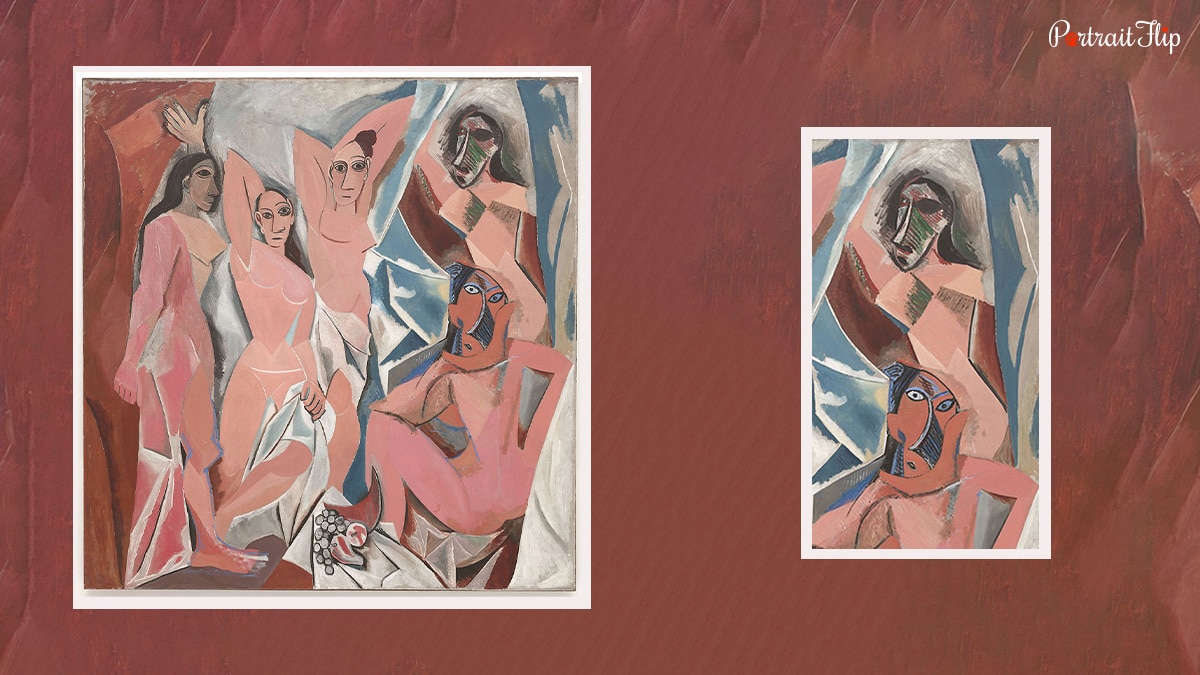
There are a total of five women painted in Les Demoiselles by Pablo Picasso. All of them are entirely nude showing off their bodies to a potential customer.
However, two of them were painted in the extreme right of the frame wearing primitive tribal masks.
These masks give an idea of the ethnicity of these women. They seem to be part of either a primitive or ethnographic tribe.
Tall Women
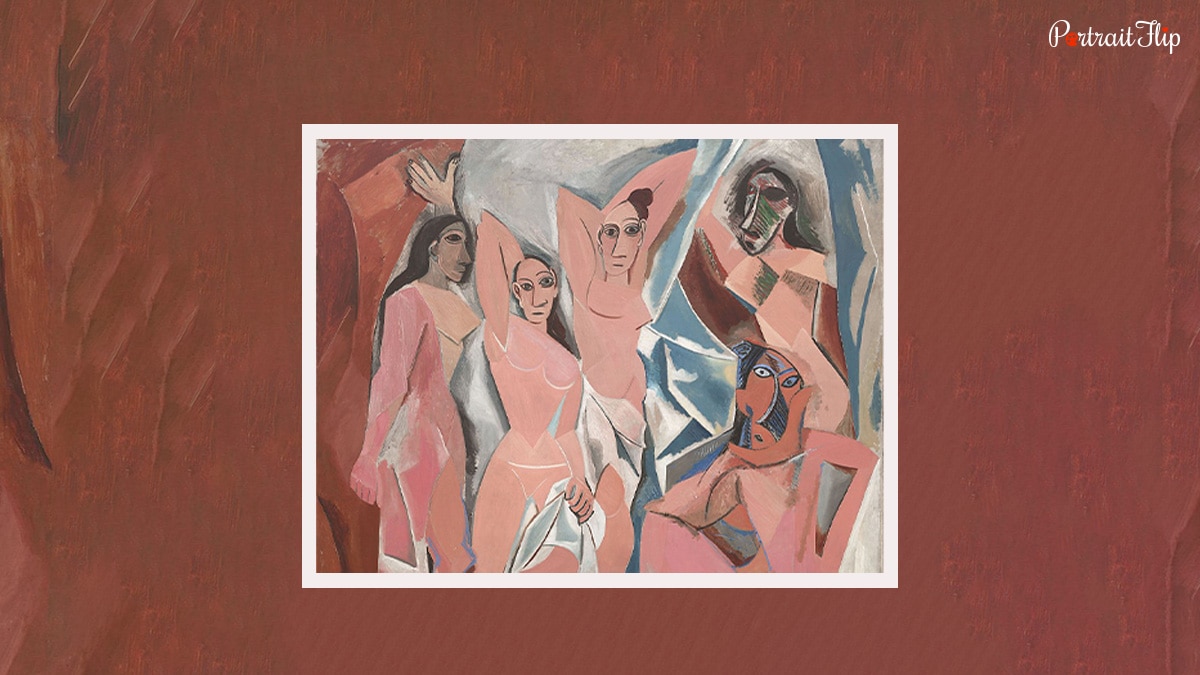
Picasso has kept the height of these women very unusual. They all stand a towering height of
seven feet.
This fact also leads to the inculcation of a primitive element in Les Demoiselles d’Avignon. Because the average height of French women is way below seven feet.
Some art critics also claim that Picasso’s biased influence came from tall Iberian sculptures before creating this masterpiece.
Composition and Analysis
Les Demoiselles might seem like a very upfront composition at a glance, It embeds a summit of layers throughout.
Being an artwork of the proto-cubism period, it contains several elements that are not easy to understand.
In order to do Les Demoiselles d’Avignon’s analysis, let’s decode this masterpiece step by step!
CUBISM
Picasso painted this artwork with elements of cubism in mind. That’s why they are evident very prominently throughout this painting.
Face: The faces of the women subjects in this painting are flat, sharp, and elongated in nature. They justify the presence of proto-cubism in this artwork.
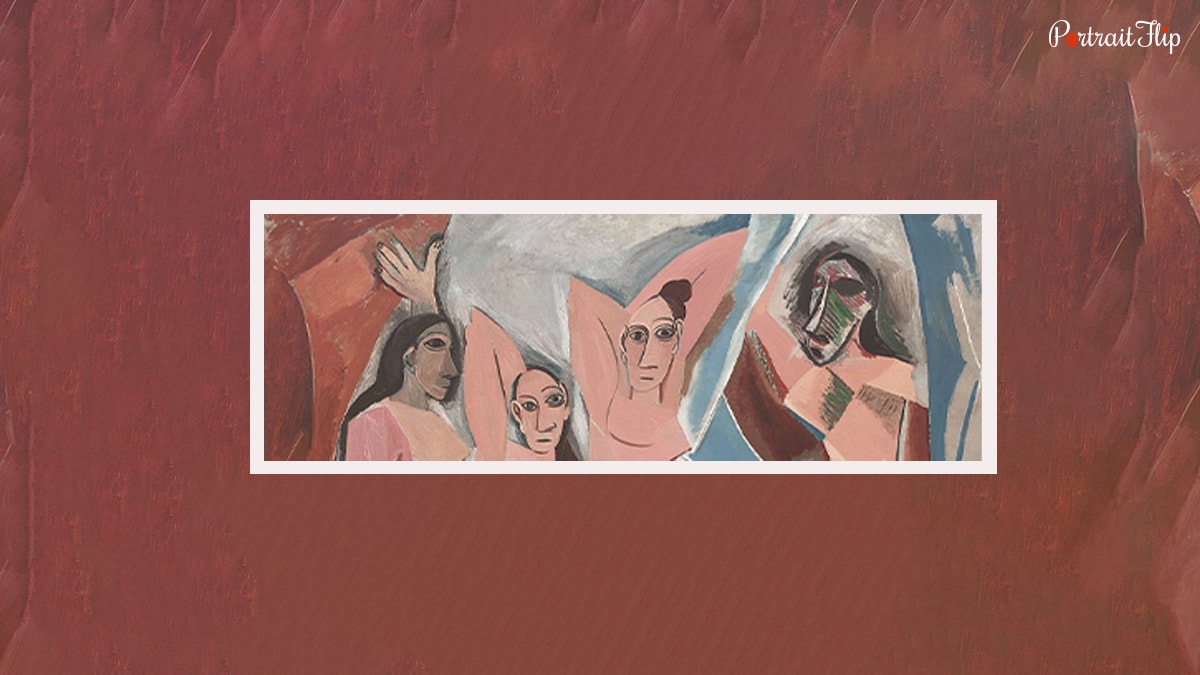
Body: Body parts of the female subjects, like legs and hands, are painted with analytical nuances in mind. They align with the overall theme of the painting very aptly.
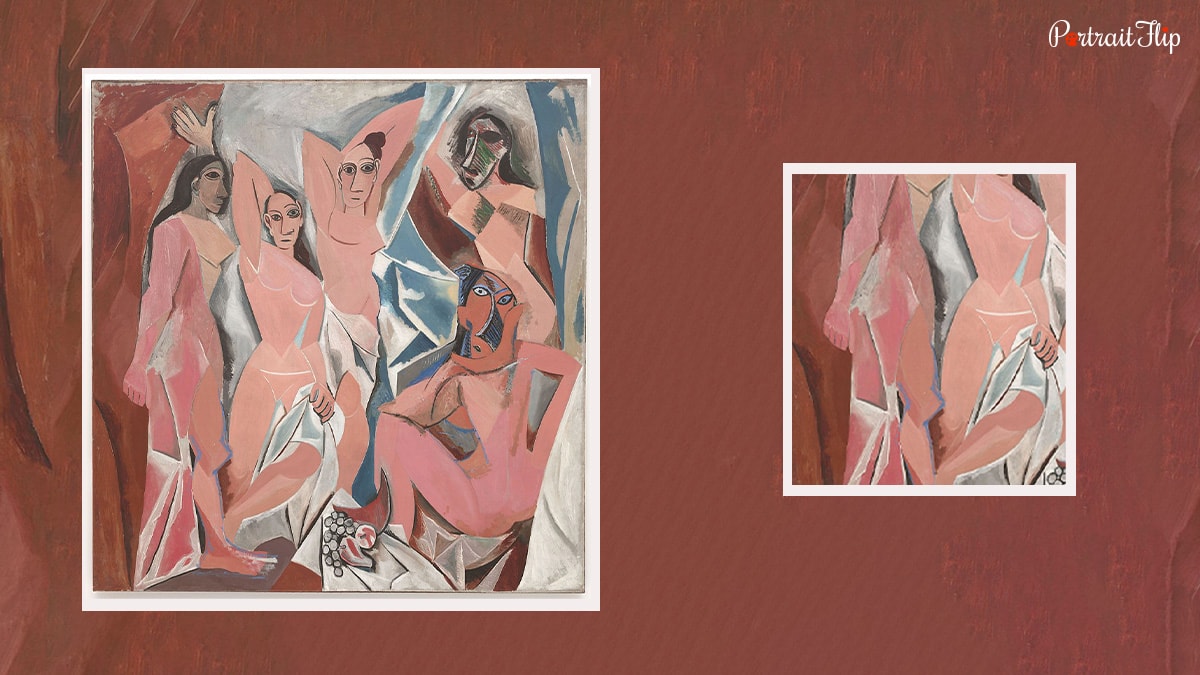
GEOMETRIC ELEMENTS
Flat Planes: Le Demoiselle d’Avignon by Pablo Picasso looks like a painting that lies somewhere between 2-Dimensional and 3-Dimensional geometry. Which is represented by the flat planes used as a base layer for representation of cubism.
Triangular Edges: Picasso has given another testament of analytical cubism in this painting by giving triangular edges to body folds of the women. Folds like elbows and knees seem to have triangular edges in order to maintain the geometrical essence of the painting.
Advanced Elements of Cubism
Apart from the artistic perspective, Pablo Picasso’s paintings are also known for their technical superiority.
It seemed he had a special connection with geometry. The way he used to embed geometrical elements was commendable.
In Les Demoiselles d’Avignon, Picasso introduced two of the most important features of cubism that intersected with 3D geometry prominently.
Spatial Depth: It’s an optical illusion that enables a 3D view of a 2D figure. This technique is used widely in figurative paintings that contain multiple perspectives. The Milkmaid is a perfect example of opulent use of spatial depth by Johannes Vermeer.
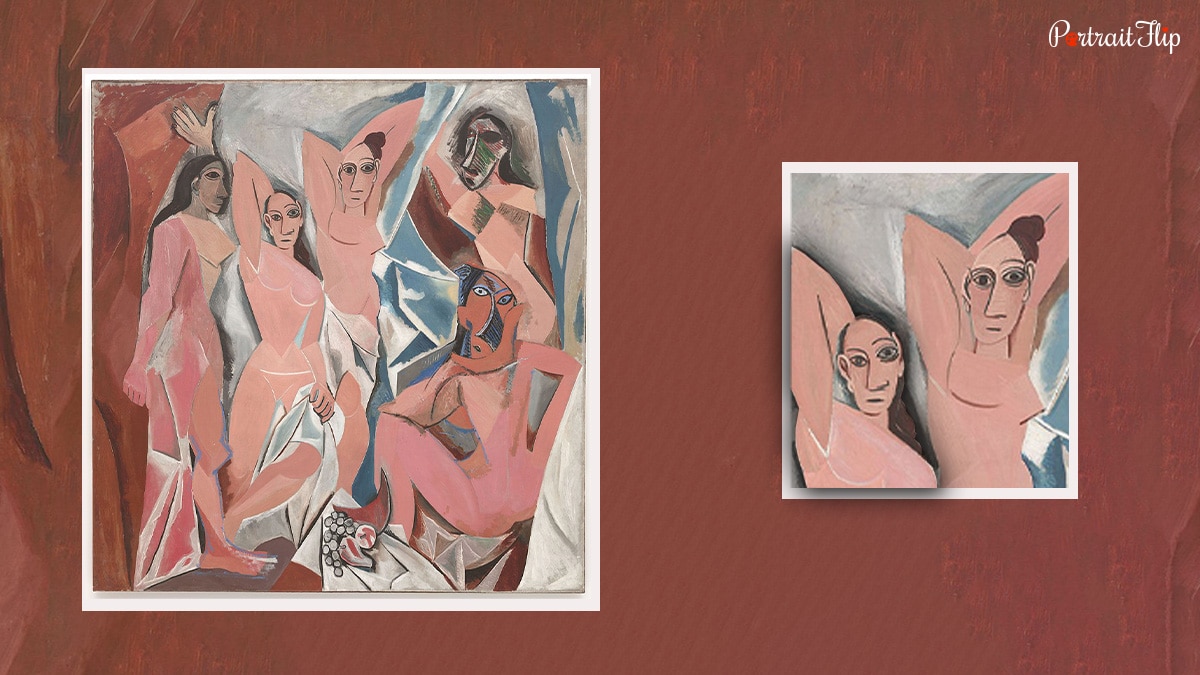
Overlapping Proportions: Another technique mastered by Picasso is overlapping the figures while painting them in a confined space. Les Demoiselles contain adequate space but Picasso used the overlapping technique in order to create a 3D effect for the viewers.
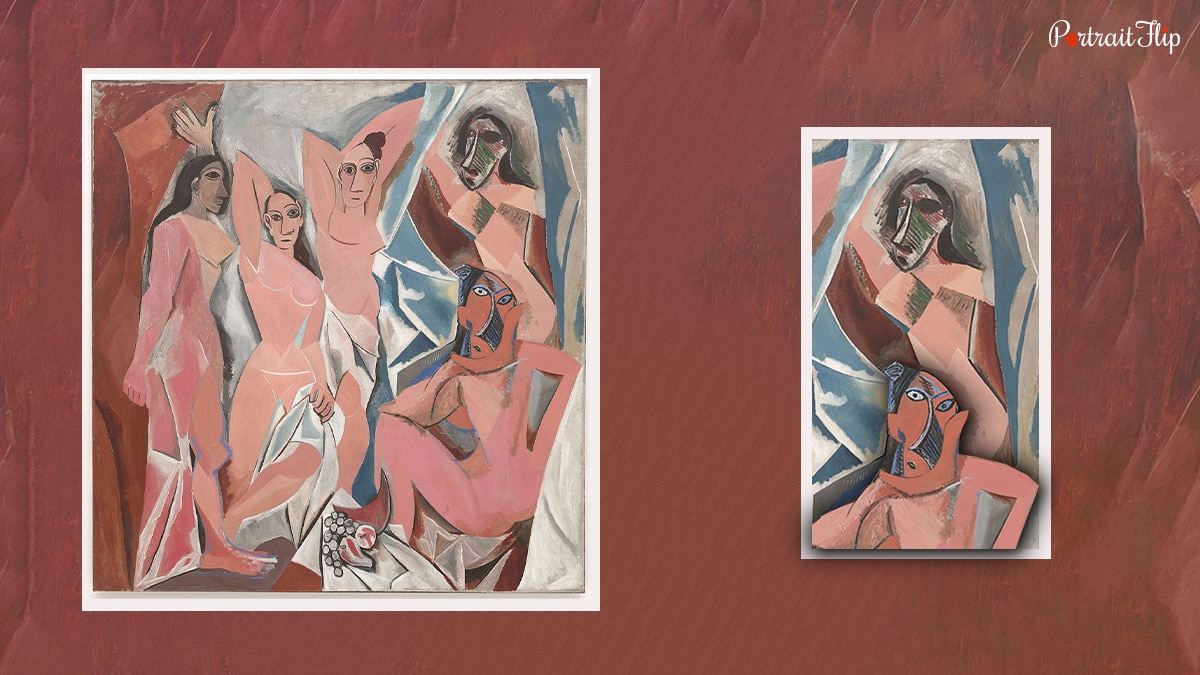
Lighting
Lighting happens to be a not so significant element for paintings like Les Demoiselles d’Avignon. This statement might sound a bit confusing in the beginning.
Let me break it down for you in a simpler way!
Since this painting is one of the first cubist paintings, It radiates the very idea of cubism in every aspect. Where lighting is not a prominent element.
Cubism’s prime focus was on creating optical illusions using analytical drawings covered in vague and murky color schemes.
This fact is evident in Picasso’s other artworks, such as The Old Guitarist and Guernica.
Les Demoiselles d’Avignon contains the amount of lighting necessary just to make the ladies identifiable along with their body structure.
Color
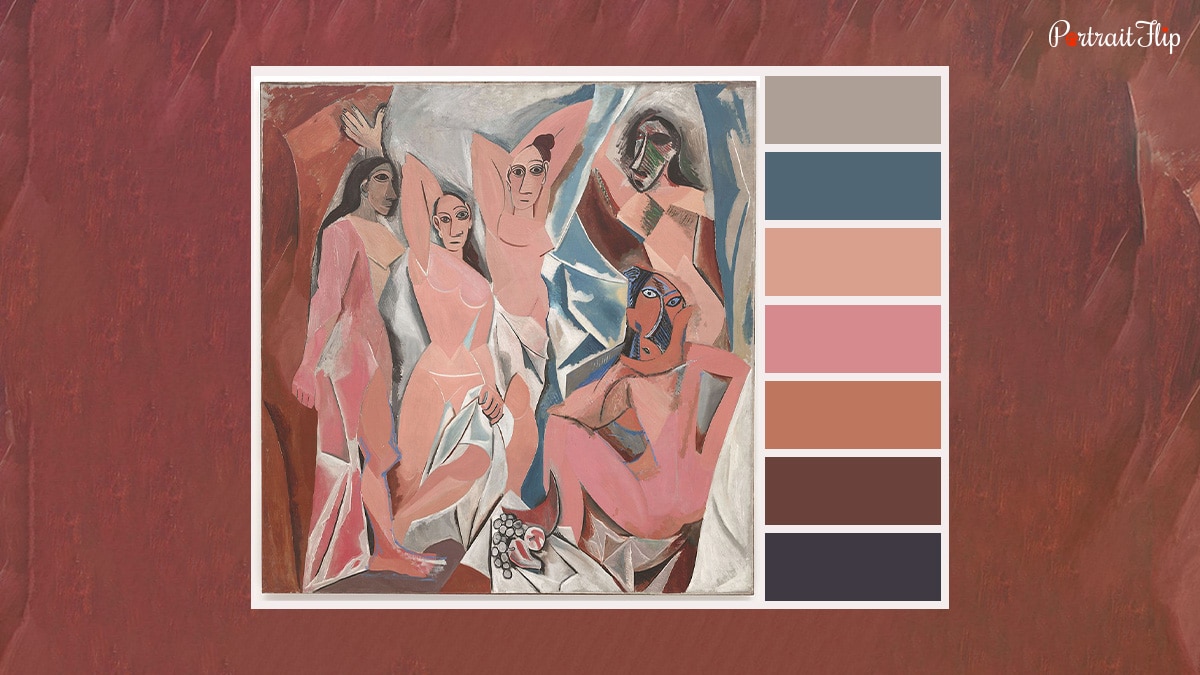
Every artwork that signifies something, comprises an expressive and evocative color scheme. So is the case with Les Demoiselles d’Avignon.
Picasso has given preference to use of red and brown colors with their different shades to cover this artwork.
In order to understand the color scheme of Les Demoiselles d’Avignon in detail, I have highlighted a few nuances in this painting:
Neutral Color Scheme: Picasso’s main motive was to present a set of optical illusions using these Iberian women as subjects. So he kept the color scheme very neutral and simple. He avoided using any tacky or bright colors to restrict the audience’s attention to the figurative part.
Using Common Colors: Many Cubist artists used to opt for easily available colors for their artworks. Most of them never experimented with new shades of basic colors. However, Picasso did not want to risk the elegance of his avant-garde artwork. So he sprinkled a few tints of white with blue to paint the background.
The Skin Color: Pigment used to paint the human skin was not found naturally in the early 20th century. It was synthesized from brown, red, white, and black in different proportions. The use and dominance of colors depended on the ethnicity of the human subject. In this painting, brown color dominates the blend.
Reception of Les Demoiselles d’Avignon
History has been witness to many controversial artworks. But none of them come even close to the level of outrage Les Demoiselles d’Avignon caused.
Imagine that you create a painting with ambiguous ideas about expressions. But, you end up provoking the art community around you.
Woah! Art is really powerful and complicated.
Public Reactions
Picasso unveiled Les Demoiselles d’Avignon in 1907. After which, he started receiving critical responses about his insensitivity towards the depiction of primitive women as prostitutes.
Some people claimed that Picasso was a subtle racist because of the way he portrayed characters and depicted subjects through his art.
Nevertheless, Picasso took the opportunity to make it clear that the human subjects are painted like that because of the recent influence of primitive an Iberian figures in his mind.
Reception by Artists
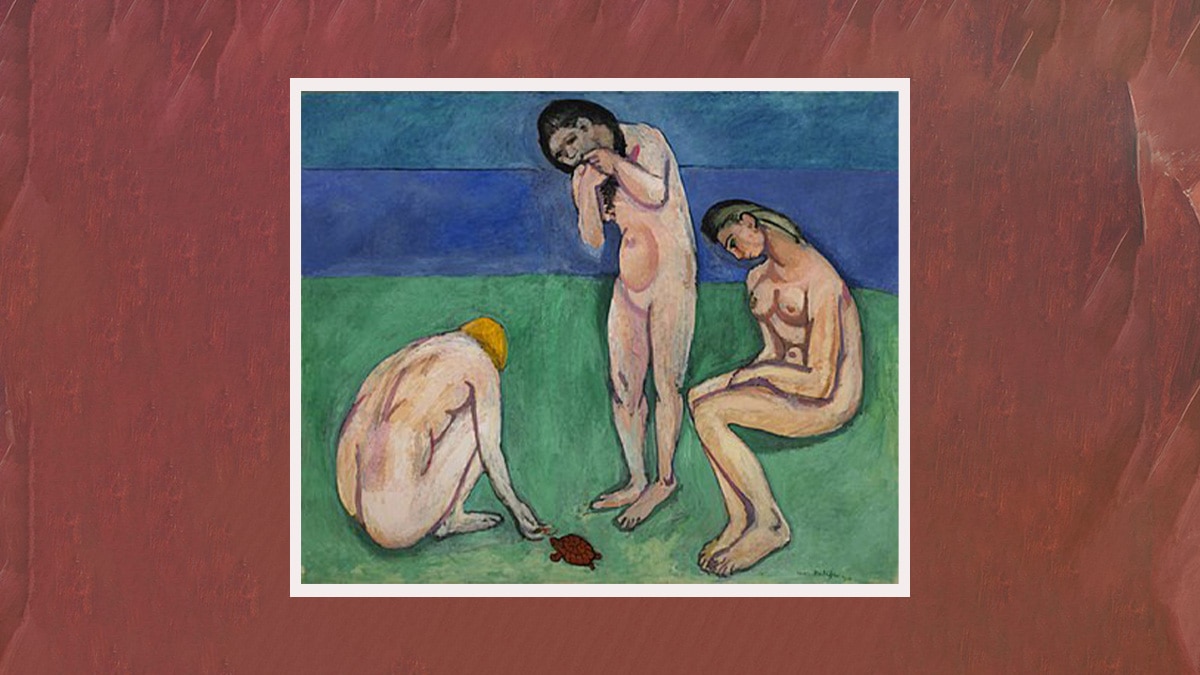
Many of his close associates criticized him for this act of mockery. Hardly any famous artist stood with Picasso that time.
His close friend, one of the famous French artists, Henri Matisse said that “ Les Demoiselles d’Avignon is a bad joke”. He referred to the element of racism in the painting.
However, Henri painted “ The Bathers with a Turtle” a year after this incident. This painting proved to be ironic for the French artist.
Influence
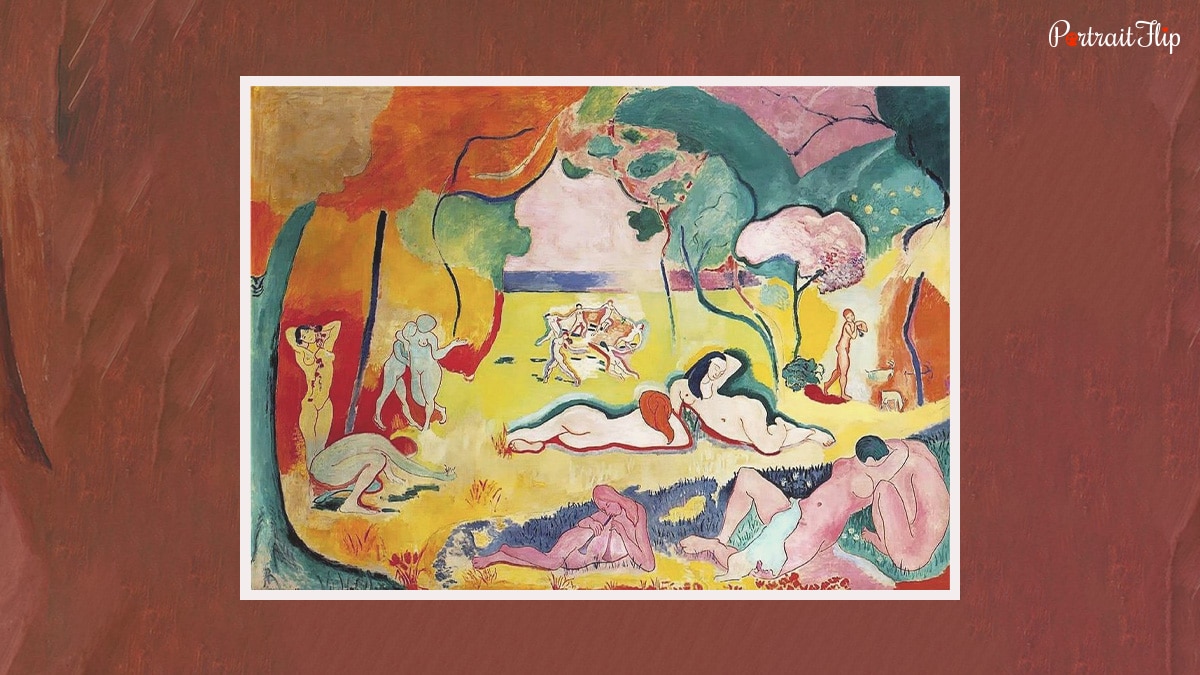
Being the flag bearer of Cubism, Les Demoiselles d’Avignon is one of the most talked about avant-garde artworks of all time.
It created a turbulence among the European artistic community during the early 20th century.
This avant-garde got inspiration from multiple sources. This fact is evident in various nuances in this painting.
One of the most familiar influences on Les Demoiselles d’Avignon is Henri Matisse’s La Joie de vivre.
It also revolves around the same concept of depicting naked women in a peculiar light.
It still remains a topic of discussion among art critics across the world.
The painting also influenced Dance by Matisse which depicts dancing figures in red figures.
Conclusion
Les Demoiselles d’Avignon is an example of how an art piece can evoke hidden emotions and create outrage.
Right from its production until now, it has been a part of every hot conversation in the art community.
For instance, if the composition of women in the painting had been a little different, this painting might not have been controversial to this magnitude.
Nevertheless, it proved to be a landmark for Pablo Picasso in the world of art!
This painting caused so much heat around the topic back then.
It’s surely one of the best souvenir to get inspired from!
But, the original copy is too hefty to buy. Well, we’re here to provide you with an exact replica of some of the very famous artworks at a very reasonable price.
Author’s Note
Hola, mi amigos,
I thank you all for staying till the end and reading my blog.
I hope this piece does justice to your time and curiosity. I’ve tried my best to write down everything about Les Demoiselles d’Avignon.
However, if you feel like contributing, then the comment section is yours!
We keep on producing such types of content. Check out our blog page!
Follow us on Instagram and subscribe to our YouTube channel for that.
FAQs
Maestro of cubism, Spanish painter Pablo Picasso produced Les Demoiselles d’Avignon painting.
Demoiselles is a French word which translates to “Young Ladies” in English.
Primitive and Iberian figures are used in the creation of Les Demoiselles d’Avignon.
Les Demoiselles d’Avignon by Picasso faced criticism because of its racially inappropriate depiction.
This immaculate artwork by Pablo Picasso refers to a liberalized depiction of traditional art. It broke the barriers between the art of abstraction and figurative painting. Hence, Cubism was born.


